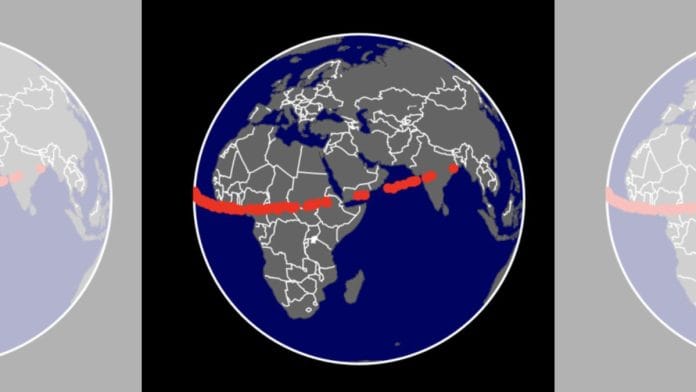New Delhi: Leonardo DiCaprio and Jennifer Lawrence’s 2021 apocalyptic film Don’t Look Up has a 2.3 percent chance of becoming real. NASA’s Asteroid Watch has warned the world about a ‘city-killer’ asteroid named 2024 YR4, which has a 1 in 43 chance of hitting the Earth in 2032, and India might be one of the places it could hit, according to analysis by the US-based privately run Asteroid Institute.
Though the chances of impact are slim, the situation is still significant enough to warrant the attention of the global planetary defence community.
“While still an extremely low possibility, asteroid 2024 YR4’s impact probability with Earth has increased from about 1 percent to a 2.3 percent chance on 22 December, 2032. As we observe the asteroid more, the impact probability will become better known,” NASA Asteroid Watch posted on X last week.
While still an extremely low possibility, asteroid 2024 YR4's impact probability with Earth has increased from about 1% to a 2.3% chance on Dec. 22, 2032. As we observe the asteroid more, the impact probability will become better known. More: https://t.co/VWiASTMBDi pic.twitter.com/Z1mpb4UPaC
— NASA Asteroid Watch (@AsteroidWatch) February 7, 2025
The potentially destructive asteroid was first detected by NASA-funded ‘Asteroid Terrestrial-Impact Last Alert System’ (ATLAS) telescope in Rio Hurtado, Chile on 27 December, 2024 and designated as ‘brightening’ as it approached Earth.
It is estimated to be between 40 metres and 100 metres wide, according to the European Space Agency. For context, this isn’t big enough to destroy the entire world, but as the name suggests, it could be a “city killer”. In 1908, a similar-sized asteroid struck a remote Siberian forest and caused devastation across 800 miles.
Asteroids are rocky remnants left over from early formation of the solar system. Their orbits are not well defined. Due to the gravitational pull of larger planets, these asteroids may cross the Earth’s orbit resulting in a potential collision.
However, official communication from NASA on 7 February did assure that it could still be ruled out as an “impact hazard”. The space agency will continue to monitor its movement until 2028 to decide how much of a risk it actually poses. The current risk chances could either continue to rise, said the statement, or it could reduce.
What if 2024 YR4 collides with Earth?
Space agencies have assigned a Level 3 rating, out of 10, on the Torino Impact Hazard Scale—a tool used to categorise the impact hazard of asteroids, comets and other near-Earth objects.
The Level 3 rating estimates that the collision will cause “localised destruction” and not a catastrophic impact. This rating warrants attention by astronomers and public officials, if the expected encounter is less than a decade away.
Despite what Torino scale says, there are still levels of destruction an asteroid can cause based on where it strikes. For example, the 1908 asteroid impact would have caused much wider destruction had it hit a major city rather than a remote forest. A tool created by Purdue University scientists lets people assess the scale of destruction of any asteroid based on its size.
Global response
Astronomers are planning to use the James Webb Space Telescope in order to study the infrared light that 2024 YR4 emits, rather than the visible light it reflects for more precise information.
Webb’s Mid-Infrared Instrument (MIRI) instrument will be used to get a more precise estimate of the size of the asteroid, which in turn will be used by the European Space Agency, NASA and other space organisations to determine the necessary response measures required to minimise the impact.
American physicist Ed Lu posted on X that the B612 Asteroid Institute has mapped out the different scenarios of YR4 hitting the Earth, and around three possibilities show that it could hit India, too. The map created by Lu’s team shows YR4’s trajectory largely around the equator, with some Caribbean countries, Central Africa and India being the main potential targets.
@b612foundation has taken the orbit and uncertainty of asteroid 2024YR4, sampled 10K trajectories from the current uncertainty, and propagated them forward. 2.3% of those hit the Earth on Dec.22, 2032. Here is where they hit. pic.twitter.com/DP21bMeIdT
— Ed Lu (@astroEdLu) February 7, 2025
The emerging threat calls for international collaboration through activation of organisations like the International Asteroid Warning Network and the Space Mission Planning Advisory Group, which coordinate the sharing of information and response to asteroids.
Meanwhile, China has organised an entire planetary defence team to counter the threat of near-earth objects like asteroids and comets.
The Aerospace Information Research Institute, Chinese Academy of Sciences, responsible for aerospace engineering research and implementation, and Earth observation, is recruiting graduates to study asteroid monitoring and create early warning systems, according to the notice posted last month on the WeChat account of the journal Chinese Space Science and Technology.
Also Read: How SpaDeX docking is ISRO’s giant leap to putting 1st Indian on Moon






